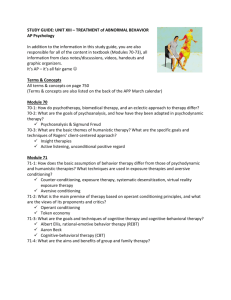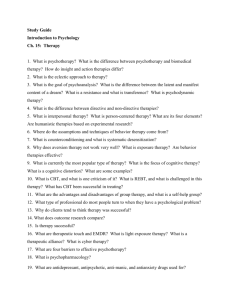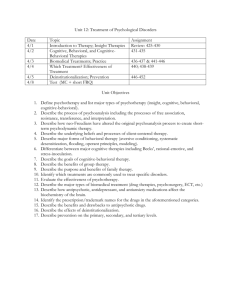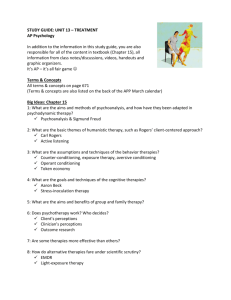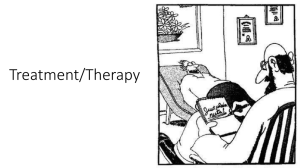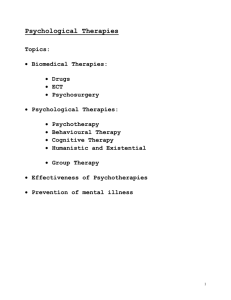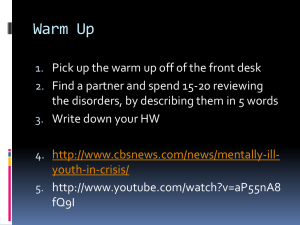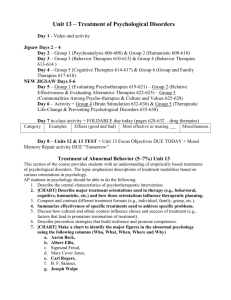Psychological Disorders Treatment: Study Guide
advertisement
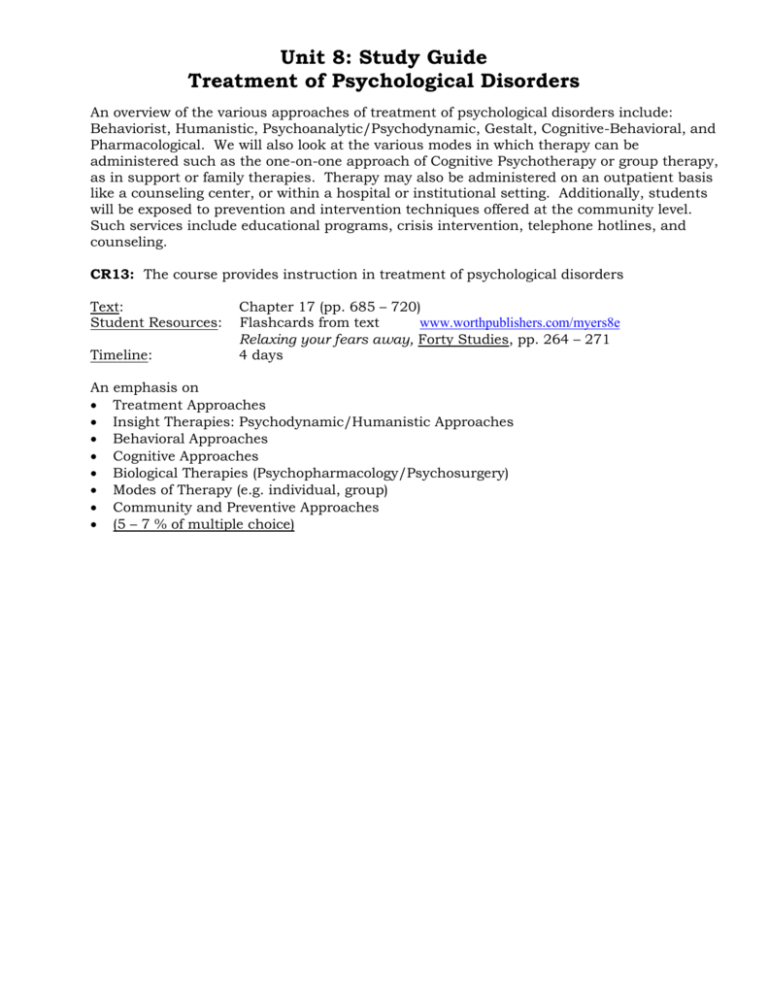
Unit 8: Study Guide Treatment of Psychological Disorders An overview of the various approaches of treatment of psychological disorders include: Behaviorist, Humanistic, Psychoanalytic/Psychodynamic, Gestalt, Cognitive-Behavioral, and Pharmacological. We will also look at the various modes in which therapy can be administered such as the one-on-one approach of Cognitive Psychotherapy or group therapy, as in support or family therapies. Therapy may also be administered on an outpatient basis like a counseling center, or within a hospital or institutional setting. Additionally, students will be exposed to prevention and intervention techniques offered at the community level. Such services include educational programs, crisis intervention, telephone hotlines, and counseling. CR13: The course provides instruction in treatment of psychological disorders Text: Student Resources: Timeline: Chapter 17 (pp. 685 – 720) Flashcards from text www.worthpublishers.com/myers8e Relaxing your fears away, Forty Studies, pp. 264 – 271 4 days An emphasis on Treatment Approaches Insight Therapies: Psychodynamic/Humanistic Approaches Behavioral Approaches Cognitive Approaches Biological Therapies (Psychopharmacology/Psychosurgery) Modes of Therapy (e.g. individual, group) Community and Preventive Approaches (5 – 7 % of multiple choice) Unit 8: Treatment of Psychological Disorders Key Terms Psychotherapy Psychoanalysis*(Freud) Interpretation Client-Centered Therapy* (Rogers) Unconditional Positive Regard* Counterconditioning (Mary Cover Jones) Systematic Desensitization Cognitive Therapy Cognitive-Behavior Therapy Seasonal Affective Disorder (SAD) Norepinephrine* Prozac (Fluoxetine) Placebo* Lithium Electroconvulsive Therapy (ECT) Outpatient Psychosurgery Key People Sigmund Freud* ___ Hans Eysenck ___ A. B. C. D. E. F. Mary Cover Jones* Egas Moniz Eclectic perspective* Resistance Transference Active Listening Behavior Therapy Aversive Conditioning Token Economy* Meta-Analysis Family Therapy Psychopharmacology Serotonin* Dopamine* Double-Blind Studies* Support Groups Encounter Groups Institutional Setting Lobotomy ___ ___ Carl Rogers* Joseph Wolpe* ___ ___ Just eat, Peter. The rabbit won’t harm you. Sit down on the couch and just talk. You want to get over your phobia? I’ve got a step by step approach. Psychotherapy is the answer to helping you. Patient, I mean client. The focus is on you. A nobel prize for me? Too bad, the lobotomy later was abused. Learning Outcomes (from the Myers text – Chapter 17: Therapy) 1. Discuss some ways that psychotherapy, biomedical therapy, and an eclectic approach to therapy differ. 2. Define psychoanalysis, and discuss the aims of this form of therapy. 3. Describe some of the methods used in psychoanalysis, and list some critisicms of this form of therapy. 4. Contrast psychodynamic therapy and interpersonal therapy with traditional psychoanalysis. 5. Identify the basic characteristics of the humanistic therapies, and describe the specific goals and techniques of Carl Rogers’ client-centered therapy. 6. Explain how the basic assumption of behavior therapy differs from those of traditional psychoanalytic and humanistic therapies. 7. Define counterconditioning, and describe the techniques used in exposure therapies and aversive conditioning. 8. State the main premise of therapy based on operant conditioning principles, and describe the views of proponents and critics of behavior modification. 9. Contrast cognitive therapy and cognitive-behavior therapy, and give some examples of cognitive therapy for depression. 10. Discuss the rationale and benefits of group therapy, including family therapy. 11. Explain why clients tend t overestimate the effectiveness of psychotherapy. 12. Give some reasons why clinicians tend to overestimate the effectiveness of psychotherapy, and describe two phenomena that contribute to clients’ and clinicians’ misperceptions in this area. 13. Describe the importance of outcome studies in judging the effectiveness of psychotherapies, and discuss some of these findings. 14. Summarize the findings on which psychotherapies are most effective for specific disorders. 15. Evaluate the effectiveness of eye movement and desensitization and reprocessing (EMDR) and light exposure therapies. 16. Describe the three benefits attributed to all psychotherapies. 17. Discuss the role of values and cultural differences in the therapeutic process. 18. Define psychopharmacology, and explain how double-blind studies help researchers evaluate drug’s effectiveness. 19. Describe the characteristics of antipsychotic drugs, and discuss their use in treating schizophrenia. 20. Describe the characteristics of antianxiety drugs. 21. Describe the characteristics of antidepressant drugs, and discuss their use in treating specific disorders. 22. Describe the use and effects of mood-stabilizing medications. 23. Describe the use of electroconvulsive therapy in treating severe depression, and discuss some possible alternatives to ECT. 24. Summarize the history of the psychosurgical procedure known as a lobotomy, and discuss the use of psychosurgery today. 25. Explain the rationale of preventive mental health programs.

